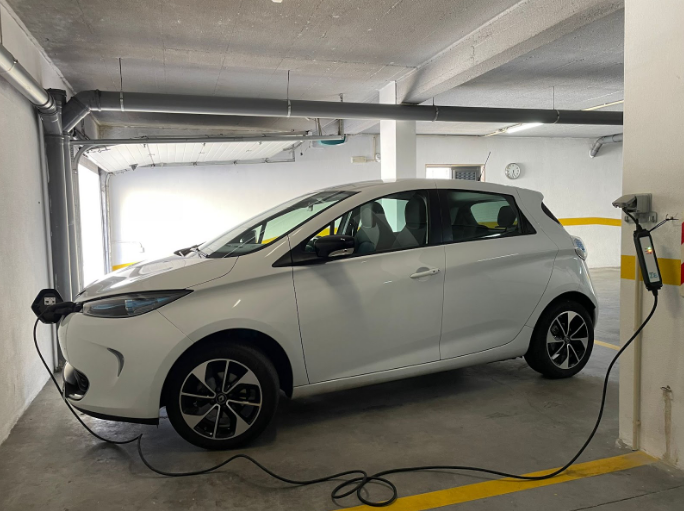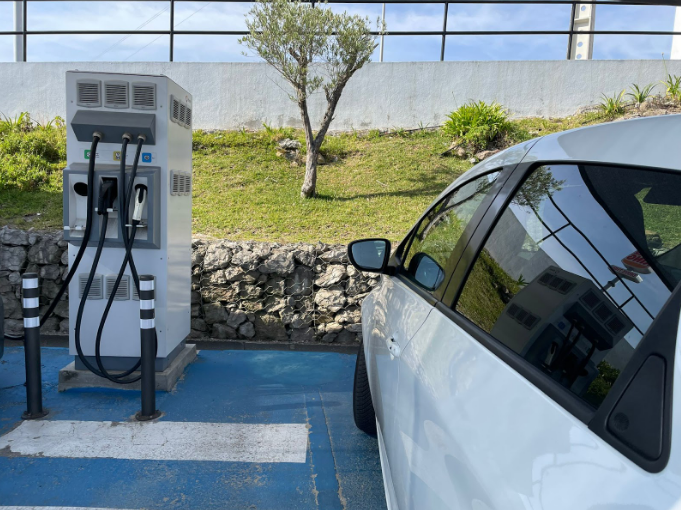Are you considering getting a Renault Zoe but feeling uncertain about how to charge it? Or do you already own a Zoe and want to ensure you’re doing everything right to keep your battery’s health in top shape?
When you first start learning about charging an electric vehicle, it’s overwhelming.
I know the feeling. But the reality is: it’s not that hard. Once you learn your way around the topic, it will become a seamless part of your daily routine.
In this article, we will dive into the world of charging the Renault Zoe, combining recommended guidelines with my own experience as a Zoe owner.
We will explore the charging capabilities of this car. We’ll also include the advancements of the R110 Z.E. 50 model over its predecessor, the R110 Z.E. 40. Understanding these differences is key to making informed decisions about charging options.
Whether you’re charging at home, seeking tips for maximizing efficiency, or venturing into public charging, we’ve got you covered. Join me as we go through the best tips for charging the Renault Zoe!
Understanding the Renault Zoe’s Charging Capabilities
Before we dive into the specific tips, let’s take a moment to explore the charging options at your disposal. This will help you make the right choice about how and where you charge your Zoe.
The Renault Zoe boasts a range of charging options, ensuring flexibility and convenience to keep the battery topped up.
You can choose between AC (alternating current) and DC (direct current) charging each with its pros and cons.
AC charging is usually used at home or in some public charging stations. It offers a reliable and accessible way of charging your Zoe while being softer on the battery’s health. The downside is that this is a slower process, that will typically take several hours. Think around 8h, but it can vary greatly depending on your exact conditions.
On the other hand, DC charging is available at rapid charging points. It provides a faster charging experience, perfect for long-distance excursions. But it comes at a cost. It’s tougher on the battery and you shouldn’t use it regularly if you want to preserve the battery’s lifespan.
When it comes to charging speeds, you will find some differences depending on the Zoe model you own.
In my case, I have a Renault Zoe R110 Z.E. 40, with a 41 kWh battery size and limitations in rapid charging capabilities. Even in DC, it has a maximum charging speed of just 22 kW, lagging behind the average EV. I haven’t found that to be an issue so far, but it depends on what you use your car for. If you do a lot of long trips, waiting for 2h to fully charge the battery is not practical.
But the newer model, the Renault Zoe R110 Z.E. 50 has an enhanced battery size and charging capabilities. It enables you to charge at rapid charging stations and delivers a maximum charging speed of 46 kW. Additionally, with an impressive AC charging speed of 22 kW, it surpasses many other EVs’ AC charging speeds.
To put it into perspective, using its charging speed of 46 kW, the Renault Zoe R110 Z.E. 50 can get fully charged in around 1 hour and 7 minutes.
How To Maximizing Home Charging Efficiency

When I started thinking about getting an EV, I talked to a friend who already owned one. The first thing he asked me was “Do you have a way of charging it at home?”. After owning my Zoe for a year, I agree with him. If the answer is “no”, you should really think if getting an electric car is the smart choice for you.
Having a charging station at home enables convenient overnight charging, ensuring a full battery each morning. If that’s not possible, you can still use a regular power outlet, although charging times will be longer.
Let’s explore some tips and tricks to make the most of your home charging station.
- Schedule charging during off-peak hours: Take advantage of lower electricity rates during off-peak hours. Usually, these happen late at night or early in the morning. Doing this will benefit your wallet and support a more sustainable energy grid.
- Use smart charging features: Many charging stations and electric vehicle supply equipment (EVSE) offer smart charging capabilities. These allow you to schedule charging sessions, track energy consumption, and even optimize charging based on renewable energy availability.
- Watch and control charging remotely: With the help of smartphone apps, such as the Renault App, you can control your Zoe’s charging remotely. I use this frequently to know at which point in the charging process my Zoe is. It allows me to keep an eye on it wherever I am, and only go and disconnect it once it reaches my intended battery level.
- Precondition the cabin and battery: The Renault Zoe comes equipped with a feature known as pre-conditioning. You can learn more about it in this Youtube video below. It allows you to warm up or cool down the cabin and battery while the vehicle is still connected to the charger. If you do this before starting your journey, you can optimize the car’s performance and range. And yes, it’s as good as it sounds! I use this on hot days to cool down the car before I get to it but, mostly, to heat it up on cold days. If you’ve ever gotten to your car in the morning and had trouble holding the wheel because it is so cold, this is a game changer!
By using these simple home charging tips, you can get the most out of of charging your Renault Zoe’s.
Dealing With Fast Charging and Long-Distance Travel
Fast charging and long-distance travel are two aspects that go hand in hand.
With the ability to rapidly charge your Zoe, you can embark on longer journeys, knowing that our vehicle’s charging needs will be met along the way. Let’s explore fast charging and discover how it improves your long-distance travel.
- Use rapid charging stations: Rapid charging stations, or DC fast chargers, are the heroes of long-distance travel. These high-powered chargers significantly reduce charging times compared to standard AC chargers. Get familiar with the locations of rapid charging stations along your intended route. Depending on where you’re going, there are different apps that can help you with that. In the UK, you can use, for example, Bonnet or PlugShare.
- Consider charging networks and memberships: Explore the charging networks available in your area and join memberships or programs. Many networks offer access to a wide range of charging stations, simplified payment options, and real-time status updates. By being part of a charging network, you can broaden your charging options and enhance your charging experience. You can check some of the UK-based ones here.
- Optimize charging sessions: When using fast charging stations, it’s crucial to make the most of your sessions. Maximize efficiency by charging your Zoe to an adequate level that allows you to reach the next charging station without stops. Aim for a balance between charging time and the desired range for your upcoming leg of the journey.
- Take advantage of amenities: Many rapid charging stations are located near amenities such as rest areas, shopping centers, or restaurants. While your Zoe charges, take the opportunity to relax, grab a bite to eat, or stretch your legs. This way, you can turn your charging stops into enjoyable breaks. I always do this, and I’ve found it has allowed me to explore places that I wouldn’t have considered otherwise.
- Be flexible and adaptable: Long-distance travel may involve unforeseen circumstances. These can include traffic, weather conditions, or unexpected detours, for example. Keep a flexible mindset and be prepared to adapt your charging strategy if needed. Also, always keep it safe, giving yourself a margin of error if things go south. This means never planning to let your battery get below a certain point. For my peace of mind, I never let my Zoe’s battery go below 20%.

General Charging Tips for the Renault Zoe
Now that we’ve seen specific tips for charging at home and at public stations, let’s look at some general tips. These are guidelines you should always keep in mind when charging your Renault Zoe.
By following these tips, you make sure your charging experience is optimized, resulting in a reliable and enjoyable driving journey.
Let’s go through the tips:
- Optimal charging levels: Aim to keep your Zoe’s battery level between 20% and 80% whenever possible. Frequent deep discharges and full charges put unnecessary stress on the battery. In turn, this will affect the battery’s lifespan. Following this recommended range allows you to strike a balance between maximizing range and preserving the battery’s health.
- Avoid extreme temperature conditions: Extreme temperatures, both hot and cold, can impact the performance and longevity of the battery. Whenever possible, try to park your Zoe in a shaded area or a garage to cut exposure to extreme heat. In colder climates, consider using pre-conditioning features to warm up the battery before driving.
- Plan for gradual charging: Rapid charging is convenient for quick top-ups during long trips. But on a regular basis, it’s advisable to rely on regular AC charging. Gradual charging, such as overnight charging at home or at the workplace, is gentler on the battery and can help optimize its lifespan. Keep rapid charging for when it’s necessary or when you’re on the road and need to reach your destination quickly.
- Regularly inspect charging equipment: Take the time to inspect your charging cable, connector, and charging station. Look out for any signs of damage, and clean the connectors as needed. This will ensure a good electrical connection and contribute to the health of your car.
- Stay informed about software updates: Renault often releases software updates for the Zoe. These can include enhancements to charging performance and efficiency. Stay connected with Renault’s official channels, such as their website or mobile app. This way you can receive notifications about software updates.
- Be mindful of charging etiquette: When using public charging stations, be considerate of others who may be waiting to charge their vehicles. Don’t leave your Zoe connected to a station after it has reached the intended charge level. This helps other EV owners to have access to the charging infrastructure when they need it.
Always try to follow these general charging tips. This way, you can optimize your charging routine and extend your battery’s lifespan. All while enjoying a reliable and efficient electric driving experience.
Conclusion
By following these tips and strategies, you can confidently embrace electric mobility. You can also rest assured that your vehicle is charged and ready for any adventure!
You will see that charging is one of those topics that seems complex at first but, once you get familiar with it, it’s quite simple. And certainly more convenient than having to drive to the petrol station to fill up your tank!
I hope this was helpful and all your questions got answered. If you want to dig deeper into the world of EVs, don’t forget to check out some of our other articles, listed below.